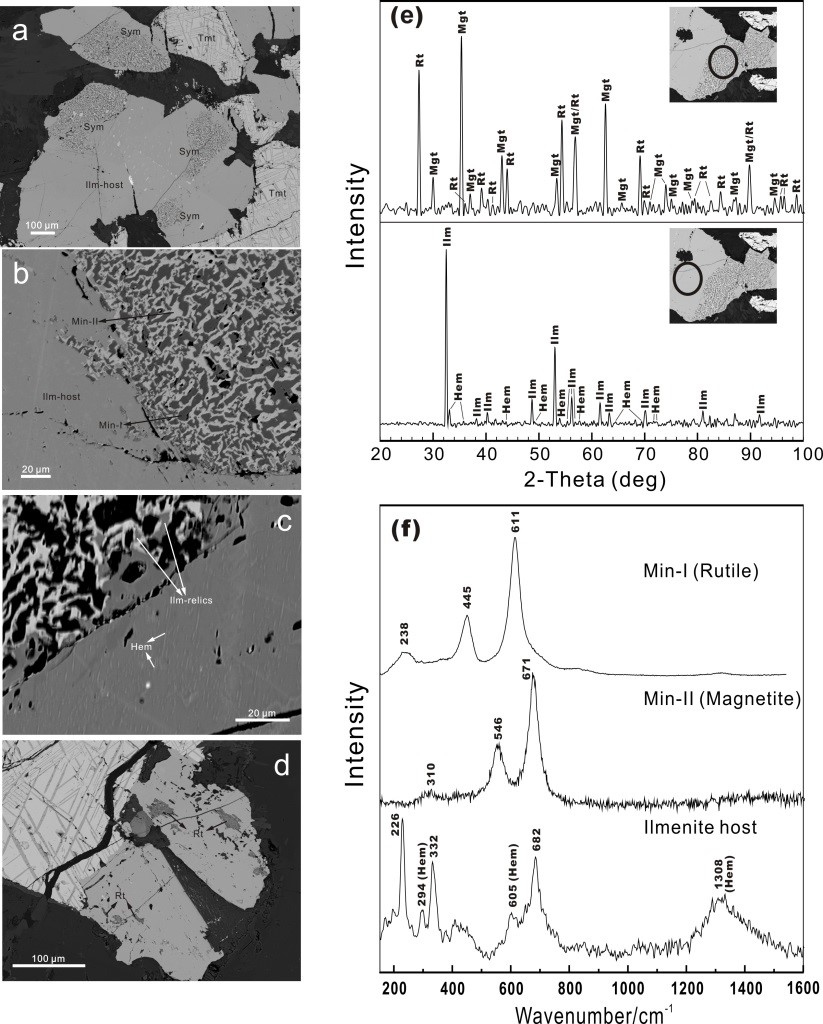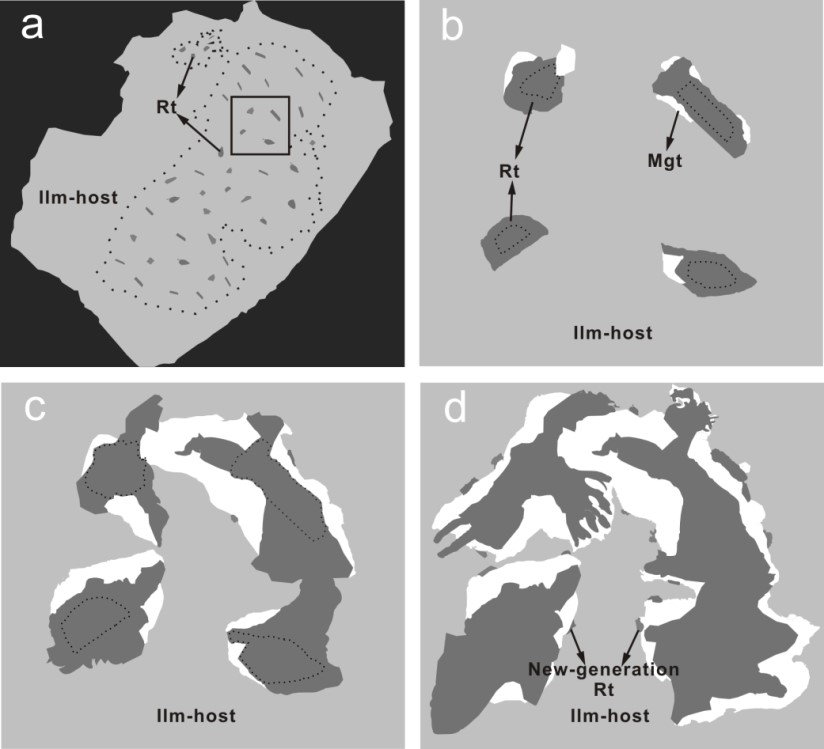广州地化所在天然钛铁矿中发现一种新的矿物共生关系—磁铁矿+金红石后成合晶
赤铁矿(Fe2O3)与钛铁矿(FeTiO3)均属于三方晶系,在高温(大于650°C)条件下可以形成完全固溶体系列,降温过程中固溶体发生不混溶分离,从而在钛铁矿中形成微米-纳米尺度的赤铁矿出溶片晶。理论上认为,磁铁矿+金红石组合应该比钛铁矿+赤铁矿组合的稳定性高,更容易存在。但是,在相关岩石学实验和野外观察中,均很难发现由钛铁矿-赤铁矿固溶体(Ilm-Hemss)转变为磁铁矿+金红石矿物组合的现象。
中国科学院矿物学与成矿学重点实验室的博士生谭伟在何宏平/王焰研究员的指导下,在我国攀西地区的新街镁铁-超镁铁层状岩体中,发现了钛铁矿中罕见的磁铁矿+金红石后成合晶。通过研究认为,相对富钛的Ilm-Hemss在亚固相条件下发生氧化,使得固溶体逐渐贫钛,从而通过首先析出金红石并形成金红石主晶界面,进而导致固溶体中的Fe3+向界面发生偏析,从而有利于磁铁矿的形成以及金红石-磁铁矿后成合晶的进一步循环生长。
该研究结果对钛铁矿-赤铁矿固溶体在亚固相条件下发生不同类型的固相转变机制以及反演层状岩体演化过程中的物理化学条件提供了新的线索和思路。相关成果已发表在国际矿物学主流期刊American Mineralogist(2015,100:2348–2351)上。
|
|
|
a-d,新街岩体钛铁矿中的磁铁矿-金红石后成合晶的BSE图像;e,磁铁矿-金红石后成合晶以及钛铁矿主晶的微区XRD图谱;f,后成合晶中金红石、磁铁矿以及钛铁矿主晶的Raman光谱。 |
|
|
|
钛铁矿中的磁铁矿-金红石后成合晶的形成机理简图 |
Magnetite-rutile symplectite derived from ilmenite-hematite solid solution in natural ilmenite from layered mafic-ultramafic intrusion
Both hematite (Fe2O3) and ilmenite (FeTiO3) are rhombohe-dral in behavior and can form a complete solid-solution series (Ilm-Hemss) above ~650 °C. A miscibility gap would separate a hematite-rich phase from an ilmenite-rich phase on cooling, resulting in abundant hematite lamellae that have width ranging from tens of micrometers to the nanoscale in the ilmenites, which is commonly observed in Fe-Ti oxide-bearing layered intrusions. In theory, an assemblage of magnetite + rutile is supposed to be more stable than, or at least thermodynamically equal to, an assemblage of ilmenite + hematite. However, the assemblage of magnetite + rutile is seldom observed in natural rocks. It is also difficult to obtain satisfactory experimental results on the equilibrium of magnetite + rutile and ilmenite + hematite assemblages due to the slow reaction rate of the Ilm-Hemss system.
In our recent work, we observed a symplectite of magnetite + rutile with an assemblage of ilmenite host + hematite lamellae in the gabbro of the Xinjie layered intrusion (SW China). Such a symplectite is ideal to investigate the factors that control the solid transformation of Ilm-Hemss. The crystallization of rutile in the symplectite is likely formed by oxidation of Ilm-Hemss, and segregation of Fe3+ in the Ilm-Hemss at the rutile-host interface triggered the crystallization of magnetite along the margin of the growing rutile, and shaped the vermicular morphology of the rutile. The crystallization of magnetite can also locally release Ti4+ to enhance the progressive growth and subsequent nucleation of rutile in the symplectite. This unusual occurrences of magnetite + rutile symplectite have an important bearing on the variation of physicochemical condition in the formation of a Fe-Ti oxide-bearing layered intrusion.
中国科学院矿物学与成矿学重点实验室&广州地化所科技处 供稿

 新闻动态
新闻动态


